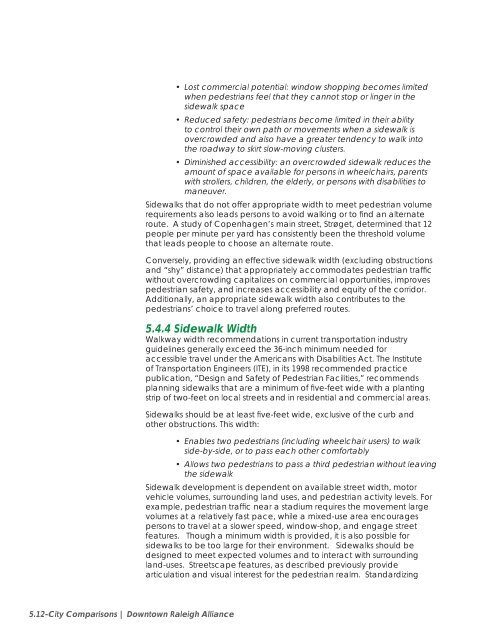Pedestrian Count Study - Downtown Raleigh Alliance
Pedestrian Count Study - Downtown Raleigh Alliance
Pedestrian Count Study - Downtown Raleigh Alliance
Create successful ePaper yourself
Turn your PDF publications into a flip-book with our unique Google optimized e-Paper software.
• Lost commercial potential: window shopping becomes limited<br />
when pedestrians feel that they cannot stop or linger in the<br />
sidewalk space<br />
• Reduced safety: pedestrians become limited in their ability<br />
to control their own path or movements when a sidewalk is<br />
overcrowded and also have a greater tendency to walk into<br />
the roadway to skirt slow-moving clusters.<br />
• Diminished accessibility: an overcrowded sidewalk reduces the<br />
amount of space available for persons in wheelchairs, parents<br />
with strollers, children, the elderly, or persons with disabilities to<br />
maneuver.<br />
Sidewalks that do not offer appropriate width to meet pedestrian volume<br />
requirements also leads persons to avoid walking or to fi nd an alternate<br />
route. A study of Copenhagen’s main street, Strøget, determined that 12<br />
people per minute per yard has consistently been the threshold volume<br />
that leads people to choose an alternate route.<br />
Conversely, providing an effective sidewalk width (excluding obstructions<br />
and “shy” distance) that appropriately accommodates pedestrian traffi c<br />
without overcrowding capitalizes on commercial opportunities, improves<br />
pedestrian safety, and increases accessibility and equity of the corridor.<br />
Additionally, an appropriate sidewalk width also contributes to the<br />
pedestrians’ choice to travel along preferred routes.<br />
5.4.4 Sidewalk Width<br />
Walkway width recommendations in current transportation industry<br />
guidelines generally exceed the 36-inch minimum needed for<br />
accessible travel under the Americans with Disabilities Act. The Institute<br />
of Transportation Engineers (ITE), in its 1998 recommended practice<br />
publication, “Design and Safety of <strong>Pedestrian</strong> Facilities,” recommends<br />
planning sidewalks that are a minimum of fi ve-feet wide with a planting<br />
strip of two-feet on local streets and in residential and commercial areas.<br />
Sidewalks should be at least fi ve-feet wide, exclusive of the curb and<br />
other obstructions. This width:<br />
• Enables two pedestrians (including wheelchair users) to walk<br />
side-by-side, or to pass each other comfortably<br />
• Allows two pedestrians to pass a third pedestrian without leaving<br />
the sidewalk<br />
Sidewalk development is dependent on available street width, motor<br />
vehicle volumes, surrounding land uses, and pedestrian activity levels. For<br />
example, pedestrian traffi c near a stadium requires the movement large<br />
volumes at a relatively fast pace, while a mixed-use area encourages<br />
persons to travel at a slower speed, window-shop, and engage street<br />
features. Though a minimum width is provided, it is also possible for<br />
sidewalks to be too large for their environment. Sidewalks should be<br />
designed to meet expected volumes and to interact with surrounding<br />
land-uses. Streetscape features, as described previously provide<br />
articulation and visual interest for the pedestrian realm. Standardizing<br />
5.12-City Comparisons | <strong>Downtown</strong> <strong>Raleigh</strong> <strong>Alliance</strong>







